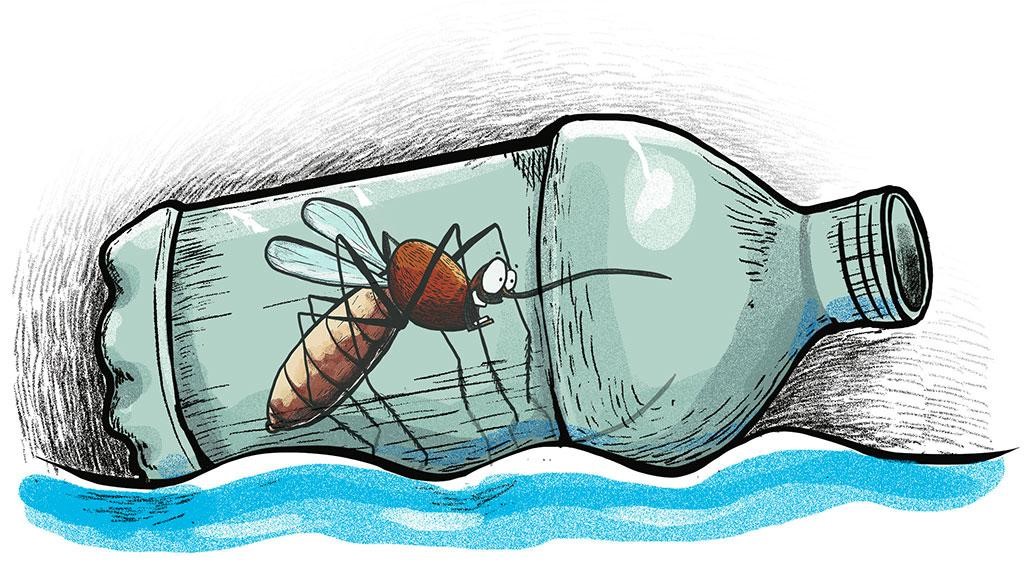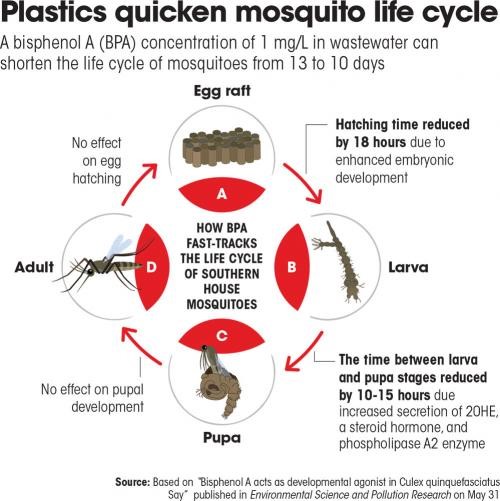Description

Disclaimer: Copyright infringement not intended.
Context: A study conducted in Thiruvananthapuram, Kerala, suggests it can indirectly aid in the spread of vector-borne diseases in humans and animals.
Details:
About:
- Bisphenol A (BPA) is a chemical produced in large quantities for use primarily in the production of polycarbonate plastics.
- It is found in various products including shatterproof windows, eyewear, water bottles, and epoxy resins that coat some metal food cans, bottle tops, and water supply pipes.
Effects:
- The adverse effect of bisphenol A, or BPA, on human health is well known.
- When ingested, the chemical that is widely used to soften plastics, paints and other products, disrupts the endocrine system by interfering with the hormones and affects the brain and prostate gland of foetuses, infants and children.
- Several studies establish that the chemical can cause high blood pressure, diabetes and cardiovascular disease in adults.
.jpeg)
How does BPA get into the body?
- The primary source of exposure to BPA for most people is through the diet. While air, dust, and water are other possible sources of exposure, BPA in food and beverages accounts for the majority of daily human exposure.
- Bisphenol A can leach into food from the protective internal epoxy resin coatings of canned foods and from consumer products such as polycarbonate tableware, food storage containers, water bottles, and baby bottles.
- The degree to which BPA leaches from polycarbonate bottles into liquid may depend more on the temperature of the liquid or bottle, than the age of the container.
- BPA can also be found in breast milk.
Findings:
- It establishes that the human-made chemical can significantly shorten the breeding time of southern house mosquitoes (Culex quinquefasciatus), a major carrier of the West Nile virus, Rift Valley fever virus and avian pox in tropical and subtropical countries, and thereby aid in its quick multiplication.
- iThis is a matter of concern as most urban wastewater canals, which serve as breeding sites for mosquitoes, are choked with BPA-laden plastic waste.
Circle of life:
- The life cycle of mosquitoes has four stages: egg, larva, pupa and adult mosquito.
- BPA has a significant impact on embryonic and larval development.

What is Plastic Pollution?
- Plastic pollution occurs when plastic has gathered in an area and has begun to negatively impact the natural environment and create problems for plants, wildlife, and even the human population.
- This includes killing plant life and posing dangers to local animals.
- Plastic is an incredibly useful material, but it is not biodegradable.

Various Causes of Plastic Pollution:
- As plastic is less expensive, it is one of the most widely available and overused items in the world today.
- Rapid urbanization and population growth increase the demand of cheap plastics.
- Since it is an affordable and durable material, it is utilized in every other way possible, from packaging materials to plastic bottles and containers, straws to plastic carry bags.
- Plastic takes 400 years and even more to Decompose. The decomposition rate of plastic typically ranges from 500 to 600 years, depending on the type.
- Abandoned Fishing Nets
- Disposal of plastic is often mismanaged; it ends up in landfills.
- Burning plastic is incredibly toxic and can lead to harmful atmospheric conditions and deadly illnesses.
Serious Effects of Plastic Pollution:
- Negative Effects on Human Health: Microplastics entering the human body via direct exposures through ingestion or inhalation can lead to an array of health impacts, including inflammation, genotoxicity, oxidative stress, apoptosis, and necrosis, which are linked to an array of negative health outcomes including cancer, cardiovascular diseases.
- Plastic-contaminated seafood: Scientists have found microplastics in 114 marine species, and around one-third of these end up on our plates.
- Upsets the Food Chain: Because it comes in sizes large and small, polluting plastics even affect the world’s tiniest organisms, such as plankton.
- Groundwater Pollution: Most of the litter and pollution affecting the world’s oceans and groundwater comes from plastics.
- Land Pollution: When plastic is dumped in landfills, it interacts with water and forms hazardous chemicals. When these chemicals seep underground, they degrade the water quality. The wind carries and deposits plastic from one place to another, increasing the land litter.
- Air Pollution: Burning of plastic in the open air leads to environmental pollution due to the release of poisonous chemicals.
- Economic impacts: Plastic pollution costs $13 billion in economic damage to marine ecosystems per year. This includes losses to the fishing industry and tourism, as well as the cost to clean up beaches. Economic costs include those linked to clean-up operations, litter removal, the repair and replacement of damaged vessels and gear, reduced fishing catches, and a decline in coastal tourism and impact on related industries.
- Marine life: The most visible and disturbing impacts of marine plastics are the ingestion, suffocation and entanglement of hundreds of marine species. Marine wildlife such as seabirds, whales, fishes and turtles, mistake plastic waste for prey, and most die of starvation as their stomachs are filled with plastic debris.
|
Plastic Waste Management Rules, 2016
- It aims to increase minimum thickness of plastic carry bags from 40 to 50 microns.
- Expand the jurisdiction of applicability from the municipal area to rural areas, because plastic has reached rural areas also.
- Extended Producer Responsibility: To bring in the responsibilities of producers and generators, both in plastic waste management system and to introduce collect back system of plastic waste by the producers/brand owners, as per extended producers responsibility
- Introduced collection of plastic waste management fee through pre-registration of the producers, importers of plastic carry bags/multilayer packaging and vendors selling the same for establishing the waste management system
- Promote use of plastic waste for road construction as per Indian Road Congress guidelines or energy recovery, or waste to oil etc. for gainful utilization of waste and also address the waste disposal issue.
|
|
PRACTICE QUESTION
Q) Examine the impact of Bisphenol A on the spread of vector diseases. (250 words)
|

https://www.downtoearth.org.in/news/pollution/accelerated-breeding-plastic-waste-in-urban-drains-can-lead-to-an-explosion-of-mosquitoes-here-s-how-85496













